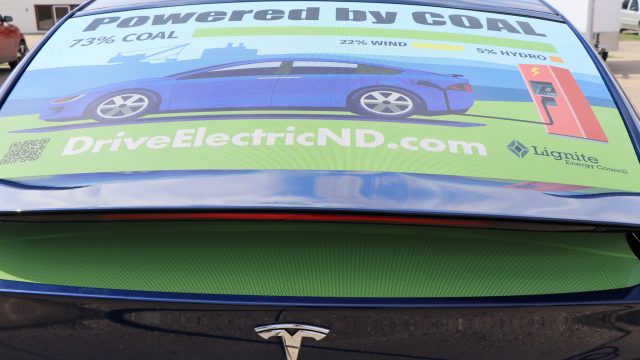Jason Bohrer: The Coal Industry Loves Electric Cars

This guest post was submitted by Jason Bohrer, President and Chief Executive Officer of the Lignite Energy Council.
In October, David Ferris, a reporter with E&E News came through North Dakota driving an electric KIA. He stopped in Bismarck and used the charger in the back of the Lignite Energy Council to repower the batteries in his car. He also took the time to interview me about why a trade association that promotes coal would be promoting electric cars. After all, isn’t the focus behind electric cars to decarbonize the transportation sector?
During the interview, I explained to him that the lignite industry and its partners have been working for more than a decade on ways to significantly reduce carbon dioxide from our coal-based facilities. I also explained that the load profile of electric cars is a natural fit for the coal-based power plants. Often, the winds in North Dakota are stronger at night than in the day. The homeowners, however, are generally asleep and the need for electricity subsides…except for the things that need to be recharged at night. That includes everything from cell phones to electric cars.
The more electric cars that are charging, the greater the chance that coal-based power plants don’t have to back off generation as far as they might otherwise.
[mks_pullquote align=”right” width=”300″ size=”24″ bg_color=”#ffffff” txt_color=”#000000″]The more electric cars that are charging, the greater the chance that coal-based power plants don’t have to back off generation as far as they might otherwise. [/mks_pullquote]
The board of directors of the Lignite Energy Council approved a marketing strategy that included the lease of a Model X Tesla, the development of a coalition in North Dakota known as Drive Electric ND and other components to the help us promote electric vehicles.
The car arrived in late January and has been getting plenty of attention ever since. One reason is that the back window carries a miniature billboard that says this vehicle is powered by homegrown coal. The charging station at the LEC also carries a similar message – the electricity produced in North Dakota is largely from the state’s plentiful lignite reserves.
The Tesla wasn’t our first attempt to promote electric vehicles. You might remember that we ran a television ad featuring Steve Burke, engineering manager at the Falkirk Mine, driving to and from work with his electric car back in 2018.
But the Tesla brought our message front and center. We are not only talking the talk, we were walking the walk. We were also driving the Tesla through a North Dakota winter and then blogging about it. We were brutally honest talking about the reduction in transportation capabilities because of the cold weather and the need to heat the interior of the car to make it comfortable.
Going to make it. Set the autopilot to 60, temp to 71 and looks like I’ll get there with 5%. pic.twitter.com/xMvjjZgS6s
— Jason Bohrer (@JasonBohrerLEC) November 20, 2019
We also liked the performance of the Tesla, not only in the summer, but all year-long. We developed a strategy where all employees of the Lignite Energy Council had a chance to drive the Tesla.
Since we all have different lifestyles, the Tesla started appearing at various places in the Bismarck-Mandan area and around the state.
As we drove, we were able to share rides with people young and old. The Tesla appeared at the state fair, county fairs, car shows, electric vehicle meetings and wherever it appeared, it turned heads. People would also comment that they saw our “Watts” driving on the Interstate.
The Lignite Energy Council is not the only entity in the state promoting electric vehicles. That’s why Drive Electric ND is such an important component of this advocacy group. Electric co-ops and electric vehicle owners are all willing to share their experiences with others. This is a pioneering effort, but the strides we made this year, will serve us well in the future.
In September, Drive Electric ND held a roundtable discussion in Bismarck that included policymakers and electric vehicle stakeholders to discuss infrastructure needs and other issues facing owners of electric vehicles. During the next year, we will continue to promote electric vehicles as more charging stations are added – especially along the interstate corridors.




